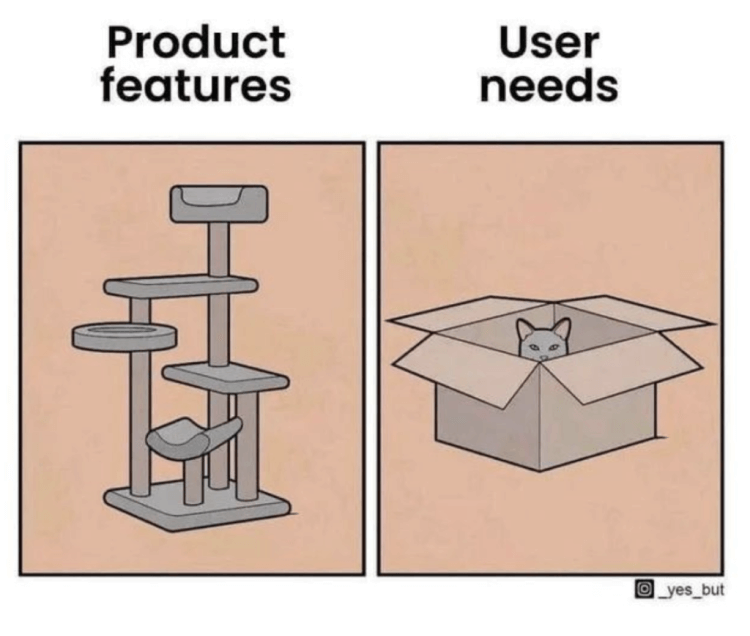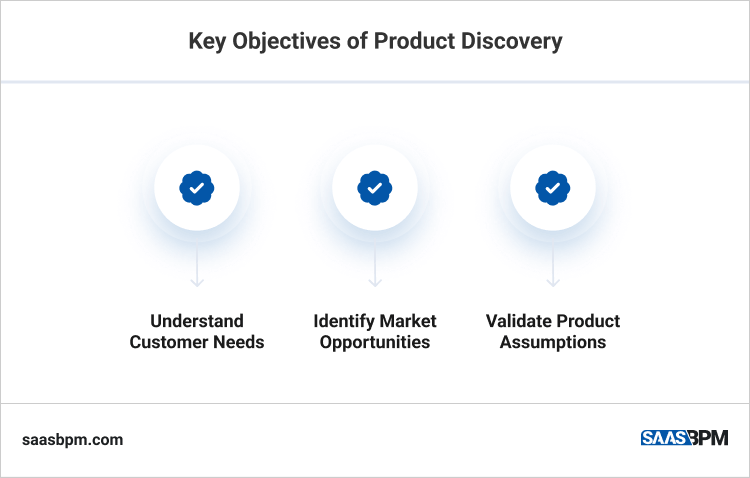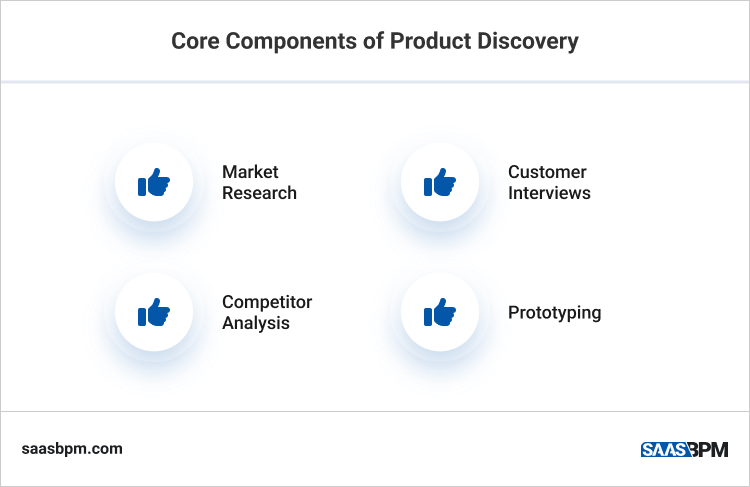Product discovery is a critical aspect of developing successful and customer-focused service.
Serving as a guiding compass, it plays an essential role in ensuring that products effectively meet user needs and deliver valuable solutions.
Product discovery helps you dig deep into what your users want, spot untapped market potential, and test out your product ideas. It sets the stage for crafting a unique solution that not only meets client expectations but also delivers real value in every feature and function.
So, gear up and get ready to unleash the power of product discovery!
What Is Product Discovery in Product Development?

So, you’re trying to build a product that rocks, right? Product discovery is the process of identifying a user problem and finding an effective solution to it.
Product discovery is the key to making strategic decisions and spending your resources wisely. It’s all about digging deep into user needs, market trends, and what the competition is up to. And let me tell you, it’s crucial for every step of building your product.
When you kick off your product development journey, product discovery helps you set your sights on the big picture and map out where you’re headed. You’ll dive into market research, user feedback, and industry trends – basically, all the juicy details that help you spot emerging opportunities and challenges.
As you’re building your product, it’s important to keep checking in and adjusting your course as needed. That’s where continuous discovery comes in – it keeps you on your toes and responsive to any changes in user needs or the market. By regularly testing your assumptions and tweaking your product ideas, you can reduce risks and boost your chances of success.
Product discovery also helps you prioritize and spend your resources wisely. By focusing on the most important features and functions, you can make the most of your investment and get your product out there faster.
Last but not least, this process encourages a culture of innovation and teamwork. When you get different teams involved in the discovery process, you can tap into a whole range of perspectives and expertise to come up with creative solutions and keep that innovation train rolling.
Key Objectives of Product Discovery

Product discovery is driven by several key objectives, each essential for informing product development and increasing the likelihood of market success.
Understand Customer Needs
One of the primary objectives of product discovery is to gain a deep understanding of customer needs, pain points, and preferences. By conducting user research, surveys, and interviews, businesses can uncover valuable insights into what drives their target audience. Understanding customer needs allows teams to develop products that address real-world problems, leading to higher levels of customer satisfaction and loyalty.
Identify Market Opportunities
Product discovery also aims to identify and capitalize on emerging market opportunities. By analyzing market trends, competitive landscapes, and industry developments, businesses can uncover gaps in the market and areas for innovation. Identifying market opportunities enables teams to position their products effectively, differentiate themselves from competitors, and seize untapped market segments.
Validate Product Assumptions
Another crucial objective of product discovery is to validate product assumptions and hypotheses. Rather than relying on guesswork or intuition, businesses use data-driven approaches such as prototyping, MVP testing, and user feedback to validate their product ideas. Validating product assumptions early and often minimizes the risk of building products that miss the mark or fail to resonate with users. It allows teams to iterate quickly, pivot when necessary, and ultimately deliver products that meet user needs and expectations.
Core Components of Product Discovery

Product discovery comprises several core components, each playing a vital role in refining the product vision, features, and positioning to meet user needs and market demands.
Market Research
Market research involves gathering and analyzing data related to industry trends, market dynamics, and customer behaviors. By understanding the broader market landscape, businesses can identify opportunities for innovation, assess market demand, and anticipate potential challenges. Market research provides valuable insights that inform strategic decision-making and ensure that products are positioned effectively within the marketplace.
Customer Interviews
Customer interviews allow businesses to directly engage with their target audience to uncover insights into their needs, preferences, and pain points. Through structured interviews and open-ended conversations, businesses can gain a deeper understanding of customer motivations, behaviors, and expectations. Customer interviews provide qualitative data that complements quantitative metrics, helping businesses develop products that resonate with their target audience and address real-world problems.
Competitor Analysis
Competitor analysis involves evaluating the strengths, weaknesses, and strategies of competitors within the market. By studying competitors’ products, marketing tactics, and customer feedback, businesses can identify opportunities for differentiation and areas for improvement. Competitor analysis enables businesses to refine their product positioning, identify unique selling points, and capitalize on market gaps. It also helps businesses anticipate competitive threats and develop strategies to maintain a competitive edge in the marketplace.
Prototyping
Prototyping involves creating preliminary versions of a product to test and validate key concepts and features. Prototypes can take various forms, including wireframes, mockups, and functional prototypes. By building prototypes early in the development process, businesses can gather feedback from stakeholders and end-users, identify potential issues or improvements, and iterate on the product design iteratively. Prototyping accelerates the development cycle, reduces the risk of building products that miss the mark, and ensures that final products meet user expectations and requirements.
The Benefits of a Structured Approach to Product Discovery
Adopting a structured and iterative approach to product discovery offers numerous benefits that contribute to the overall success of a product and the organization as a whole.
Increased Innovation
A structured approach to product discovery encourages experimentation and exploration of new ideas. By systematically exploring user needs, market trends, and emerging technologies, businesses can uncover innovative solutions to complex problems. Structured discovery processes provide a framework for generating and testing hypotheses, fostering a culture of innovation within the organization.
Reduced Development Risks
Structured product discovery mitigates development risks by validating assumptions early and often. By conducting market research, customer interviews, and prototyping, businesses can identify potential issues or roadblocks before investing significant resources into development. This proactive approach reduces the likelihood of building products that fail to meet user needs or resonate in the market, minimizing wasted time and resources.
Enhanced Customer Satisfaction
A structured approach to product discovery prioritizes understanding customer needs and preferences. By incorporating user feedback and insights into the product development process, businesses can create products that truly address user pain points and deliver tangible value. Enhanced customer satisfaction leads to increased user engagement, loyalty, and advocacy, ultimately driving long-term success and profitability for the organization.
Long-Term Advantages
Investing in a well-executed product discovery process offers long-term advantages for businesses. By continuously refining product vision, features, and positioning based on user feedback and market insights, businesses can stay ahead of the competition and adapt to evolving customer needs and market trends. A structured approach fosters agility and adaptability within the organization, enabling businesses to respond quickly to changing market conditions and maintain a competitive edge over time.
How To Incorporate Product Discovery into Your Organization
Integrating product discovery into an organization’s existing processes and culture requires a deliberate and strategic approach. By focusing on cross-functional collaboration, stakeholder buy-in, and continuous learning, businesses can effectively embed best practices into their DNA, driving innovation and success.
1. Cross-Functional Collaboration
Cross-functional collaboration is essential for successful product discovery.
By bringing together individuals from different departments, including product management, design, engineering, marketing, and customer support, businesses can leverage diverse perspectives and expertise to inform product decisions. Cross-functional teams ensure that all aspects of product development, from ideation to implementation, are considered and aligned with strategic goals.
Encourage regular communication and collaboration between teams, breaking down silos and fostering a culture of shared ownership and accountability for product success.
2. Stakeholder Buy-In
Securing stakeholder buy-in is crucial for integrating product discovery into the organization’s culture.
Engage stakeholders early and often, seeking their input and feedback throughout the discovery process. Clearly communicate the value proposition of product discovery, highlighting its impact on driving innovation, reducing risks, and enhancing customer satisfaction. Demonstrate tangible results and successes from product discovery initiatives to build confidence and support among stakeholders.
By involving stakeholders in the decision-making process and aligning product discovery efforts with organizational goals, businesses can ensure that product discovery becomes a priority across the organization.
3. Continuous Learning
Product discovery is an iterative process that requires continuous learning and adaptation. Encourage teams to embrace a growth mindset and approach product discovery as a journey of continuous improvement.
Foster a culture of experimentation and learning, where teams are encouraged to test hypotheses, gather feedback, and iterate on product concepts. Provide opportunities for skill development and knowledge sharing, such as workshops, training sessions, and cross-functional collaboration forums.
By fostering a culture of continuous learning, businesses can empower teams to stay agile and responsive to changing market conditions, driving innovation and success.
Challenges and Opportunities
While integrating product discovery into the organization offers numerous benefits, it also presents challenges that businesses must be prepared to address.
Potential challenges include resistance to change, resource constraints, and conflicting priorities among stakeholders. Overcoming these challenges requires strong leadership, effective communication, and a commitment to organizational alignment.
By proactively addressing potential barriers and leveraging opportunities for collaboration and innovation, businesses can successfully incorporate product discovery into their organization and drive long-term success.
Conclusion
Product discovery is the foundation of successful, customer-centric products. Investing in this ongoing process drives innovation, reduces risks, and enhances overall product success. By prioritizing cross-functional collaboration, stakeholder buy-in, and continuous learning, businesses can embed product discovery into their culture. Embrace product discovery as a core competency, unlocking its potential to meet user needs and drive long-term success in today’s dynamic marketplace.

